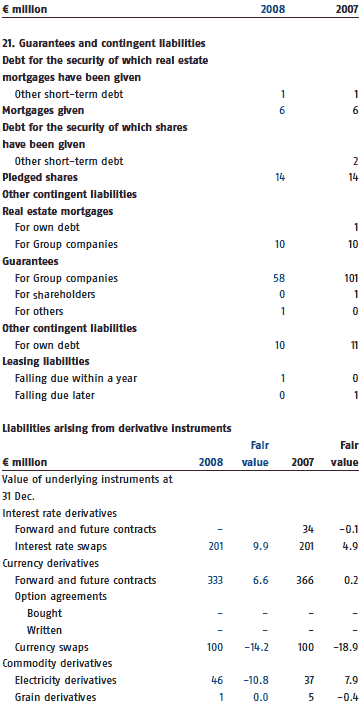Principles used for preparing the parent's financial statements
Kesko Corporation's financial statements have been prepared in compliance with the Finnish Accounting Standards (FAS).
Non-current assets
Intangible assets
Intangible assets are stated in the balance sheet at cost less
depreciation according to plan.
Depreciation plan
Other capitalised expenditure 5–14 years
Tangible assets
Tangible assets are stated in the balance sheet at cost less
depreciation according to plan.
Depreciation plan
Depreciation according to plan is calculated on a straight line
basis so as to write off the cost of tangible assets over their
estimated useful lives.
The periods adopted for depreciation are as follows:
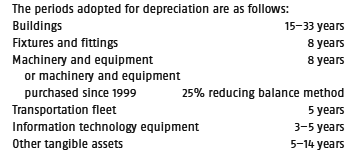
Land has not been depreciated. The total of depreciation
according to plan and the change in depreciation reserve comply
with the Finnish tax legislation. The change in depreciation
reserve has been treated as appropriations in the parent
company.
Valuation of financial assets
Marketable securities have been valued at lower of cost or net realisable value.
Foreign currencies
Items denominated in foreign currencies have been translated into Finnish currency at the average exchange rate of the European Central Bank at the balance sheet date. If a receivable or a debt is tied to a fixed rate of exchange, it has been used for translation. Exchange rate differences have been recognised in profit or loss.
Derivative financial instruments
Interest rate derivative contracts
Interest rate derivatives are used to modify loan durations. The target duration is three years and it is allowed to vary between one and a half and four years. Cash flows arising from interest rate derivative contracts are recognised during the financial year as interest income or expenses, according to the maturity date. In the financial statements, open forward agreements, futures, options and swaps are stated at market values. Unrealised revaluation is not stated as income. Any valuation losses are included in interest expenses.
Currency derivative contracts
Currency derivative instruments are used for hedging against translation and transaction risks. Forward exchange contracts are valued at the exchange rate of the balance sheet date. The rate differences arising from open derivative contracts are reported in financial items. If a derivative instrument has been used to hedge a foreign-currency-denominated asset, the value change has been recognised against that of the asset item. The premiums of option contracts are included in the balance sheet accruals until they expire, or if a value change at the balance sheet date so requires, recognition in profit or loss.
Commodity derivatives
Kestra Kiinteistöpalvelut Oy, a Kesko Corporation subsidiary, uses electricity derivatives to balance the energy costs of the Group and its retailers. Kesko's subsidiaries engaged in the agricultural trade use grain derivatives to hedge against the grain price risk. Kesko Corporation is an external counterparty in electricity and grain derivative contracts made with the bank, and internally hedges the corresponding price with the subsidiary. At no stage does Kesko Corporation have derivative positions, and thus there are no effects on profit or loss. The electricity price risk is reviewed on a 5-year time span. With respect to derivative contracts hedging the price of electricity supplied during the financial year, changes in value are recognised in Kesko under interest income and expenses. The unrealised gains and losses of contracts hedging future purchases are not recognised through profit or loss. With respect to grain derivative contracts, the open contracts in the income statement are recognised at market prices. Valuation differences related to open contracts are recognised in Kesko under financial items.
Pension plans
The pension insurances of Kesko Corporation's personnel are arranged through the Kesko Pension Fund. The Fund's A department, which provides supplementary pension benefits, was closed on 9 May 1998. The job-based retirement age agreed for a number of directors and other superiors in the Group is 60 or 62 years.
Provisions
Provisions stated in the balance sheet include items bound to by agreements or otherwise, but remain unrealised. Changes in provisions are included in the income statement. Rent liabilities for vacant rented premises no longer used for the Group business operations, as well as the losses resulting from renting the premises to outsiders, are included in provisions.
Income tax
Income tax includes the income tax payments for the period based on the profit for the period, and taxes payable for prior periods, or tax refunds. Deferred taxes are not included in the parent's income statement and balance sheet.
Notes to the income statement
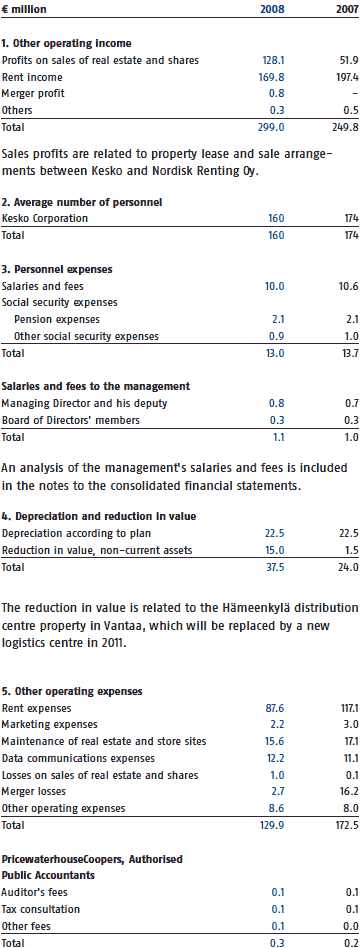
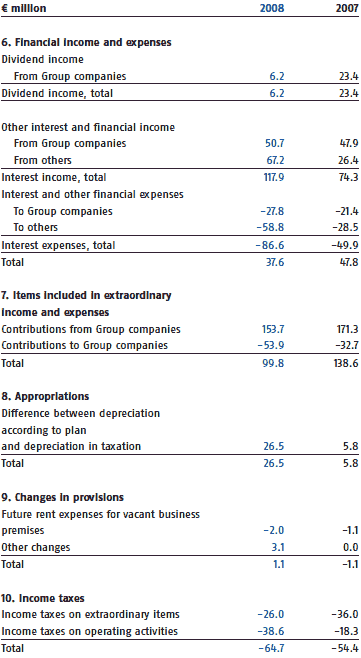
Deferred taxes
Deferred tax liabilities and assets have not been included in the balance sheet. Their total amount is immaterial.
Notes to the balance sheet
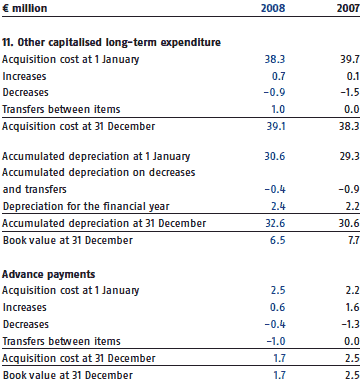

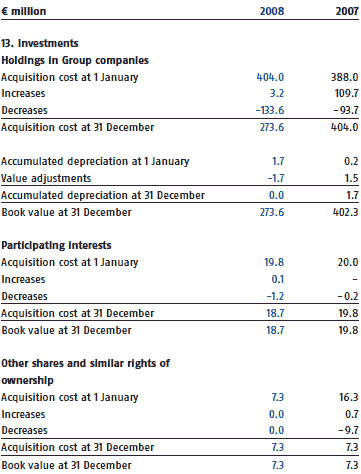
Kesko Corporation's ownership interests in other companies as
at 31 December 2008 are presented in the notes to the consolidated
financial statements.
During the period, Kesko Corporation sold its wholly-owned
subsidiaries Kauko-Telko Ltd, Tähti Optikko Group Oy and
K-Rahoitus Oy. In addition, the company founded a new subsidiary,
K-talouspalvelukeskus Oy. Among subsidiaries directly
owned by Kesko Corporation, other changes took place in real
estate companies only. During the 2007 financial year, Keswell
Ltd, a company wholly owned by Kesko Corporation merged into
Kesko Corporation.
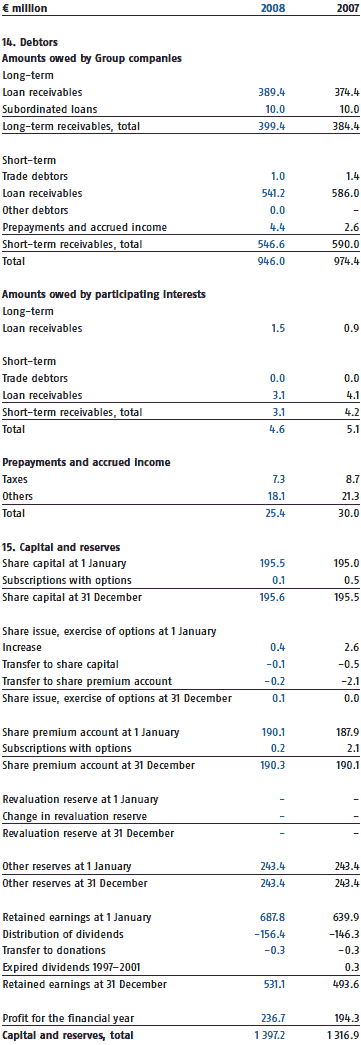
Increase in share capital
During the reporting period, the share capital was increased seven times as a result of share subscriptions with the stock options of the year 2003 option scheme. The increases were made on 11 February 2008 (€210), 28 April 2008 (€38,168), 9 June 2008 (€42,200), 28 July 2008 (€8,600), 1 October 2008 (€4,000), 27 October 2008 (€6,000) and 18 December 2008 (€15,000), and announced in stock exchange notifications on the same days. The subscribed shares were included on the main list of the Helsinki Stock Exchange for public trading with the old B shares on 12 February 2008, 29 April 2008, 10 June 2008, 29 July 2008, 2 October 2008, 28 October 2008, and 19 December 2008.
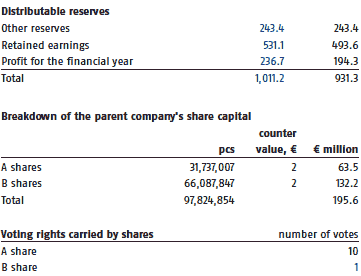
Year 2003 and 2007 stock option plans
On 31 March 2003, the Annual General Meeting resolved to gratuitously
issue a total of 1,800,000 share options to the management
of the Kesko Group as well as to a wholly-owned subsidiary
of Kesko Corporation. A deviation was made from the
shareholders' pre-emptive right to subscription since the
options form a part of the incentive and commitment programme
for the management. Each option entitles the holder
to subscribe for one new Kesko Corporation B share. The options
are marked with symbols 2003D (KESBVEW103), 2003E
(KESBVEW203) and 2003F (KESBVEW303) in units of 600,000
options each.
The Annual General Meeting of 26 March 2007 decided to grant
a total of 3,000,000 stock options for no consideration to the
Kesko Group management and the management of the other
Group companies, to the rest of the key Kesko personnel, and
to Sincera Oy, a subsidiary wholly owned by Kesko Corporation.
A deviation was made from the shareholders' pre-emptive right
to subscription since the options form a part of the incentive
and commitment programme for the management. Each stock
option entitles its holder to subscribe for one new Kesko Corporation
B share. The stock options shall be marked with symbols
2007A, 2007B and 2007C in units of 1,000,000 options each.
Share of granted options of share capital and votes
Presuming that shares are subscribed for with all of the 1,800,000 options issued under the year 2003 plan, and with all of the 3,000,000 options issued under the year 2007 plan, the shares subscribed for with options account for 4.69% of shares and 1.23% of all votes. The subscriptions made with stock options may raise the number of the company's shares to 101,712,793, and the voting rights of all shares to 387,345,856 votes. The company has no other options or other special rights entitling to shares.
Authorisations of the Board of Directors
Kesko's Annual General Meeting of 26 March 2007 authorised
the Board to decide about the issuance of new B shares.
B shares can be issued against payment to the company's
existing shareholders in proportion to their existing shareholdings
regardless of whether they consist of A or B shares, or,
deviating from shareholders' pre-emptive rights in order for the
issued shares to be used as consideration in possible company
acquisitions, other company business arrangements, or to
finance investments. The maximum number of new shares
issued is 20,000,000.
The Board of Directors was also authorised to decide about
the subscription price of the shares, to issue shares against
non-cash consideration, and to make decisions concerning any
other matters relating to share issues. The authorisation is valid
for two (2) years after the decision by the Annual General
Meeting.
The Board of Directors has no other authorisation concerning
an issue of rights, convertible bonds or options valid at the
moment.
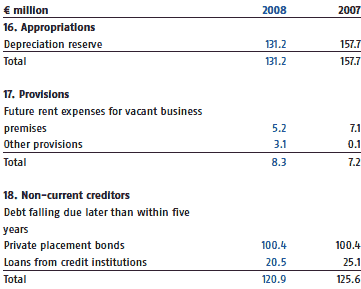
On 10 June 2004, Kesko Corporation issued a private placement of USD 120 million in the US. The arrangement consists of three bullet loans: a 10-year loan (USD 60 million), a 12-year loan (USD 36 million) and a 15-year loan (USD 24 million). Kesko has hedged the loan by using currency and interest rate swaps, as a result of which the loan capital totals €100.4 million and the fixed capital-weighted average interest rate is 5.4%.
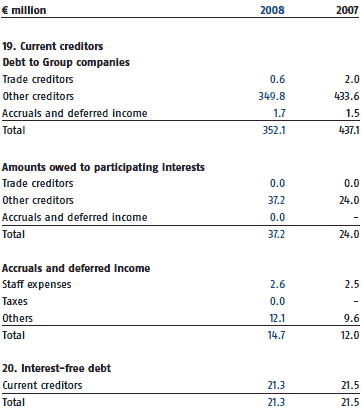
Other notes
